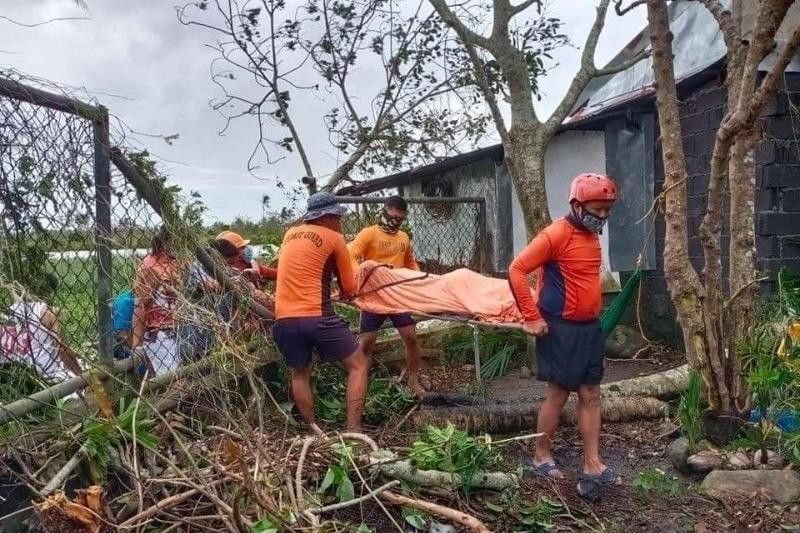Local disaster management groups must work together more and often — Harvard study

MANILA, Philippines — More collaboration will be a great help to isolated groups within the disaster management system in the Philippines, with research suggesting that local disaster rrisk reduction and response entities need to work together more, a think tank said in the aftermath of Typhoon Rolly.
This sentiment comes after the Harvard Humanitarian Initiative found in its earlier study findings published Thursday, October 29 that the country's disaster response systems showed a pronounced "preferential attachment" towards international actors, which the think tank said would lead to unempowered local agencies moving forward.
It also recorded some 114 agencies and organizations that reported no relationships with others working on disaster preparedness and resilience in the Philippines. Most of these, or 30%, were local government units and academic institutions in far-flung areas.
"As a result of the large number of isolates, there were low levels of density or network relationships; average reach or spread of information, ideas or support; and reciprocal ties between local actors in the Philippines," the study read.
READ: Disaster risk reduction must be localized amid reliance on foreign aid — study
The study, which involved face-to-face and online surveys conducted from 2017 to 2019 and a network mapping among 501 international and local organizations with disaster and climate-related projects in the Philippines, also found that due to the lack of cohesion among local organizations, it was international entities along with government units who were the top "influencers" or well-connected organizations that spread information quickly across the network.
"It would allow for greater flow of information, ideas and resources within the country’s disaster preparedness and resilience network. Since many of the isolated groups are primarily sub-national actors, this would also help to increase the local system’s ability to respond to shocks and implement a coordinated strategy,” HHI Resilient Communities program director Vincenzo said.
Bollettino also highlighted the need for local conveners or actors who can help bridge connections between groups, adding that it is important for local actors to have a diverse range of connections to others working at the sub-national and national levels, to ensure adequate access to information and resources.
HHI further recommended local DRR actors to utilize “multi-stakeholder platforms” that can help improve mutual accountability and co-creation between them, and support self-reliance in the local system.
Platforms such as social labs or “collective impact” initiatives can gather diverse local actors toward a common agenda related to climate change and disaster resilience, HHI cited.
LIST: Where you can donate for 'Rolly' relief efforts
LOOK: Philippine Coast Guard deploys helicopters to conduct typhoon damage assessment and emergency response operations in Catanduanes.
— Franco Luna (@francoIuna) November 2, 2020
Admiral George Ursabia Jr., PCG commandant, says no maritime incidents have been recorded so far. @PhilstarNews pic.twitter.com/8TiouQaaPf
Senators: Would disaster resilience department be feasible?
In an earlier statement Monday, Sen. Panfilo Lacson cast opposed calls for a disaster resilience department, pointing out that there exist other government agencies that already carry out the proposed mandate of such an addition, which would only worsen what he said was an already "bloated" bureaucracy.
"It is relatively easy to pass a law creating new departments. But would it be feasible, and will there be proper funding for it? The Department of Budget and Management says at least P1.5 billion is needed to set up the department. That does not yet include added salaries, capital outlay like office facilities, furniture, vehicles," Lacson's statement read.
"The implementation, especially of recovery and rehabilitation, will be carried out not by the proposed new department but by existing agencies such as the Department of Public Works and Highways, Department of Social Welfare and Development, and Department of Health," he also said.
It would be better to strengthen existing government agencies that have the mandate to respond to calamities, said Gordon, who chairs the Philippine Red Cross, a humanitarian organization that also addresses needs during disasters.
"It doesn't thrill me that we have to create departments... I'm ambivalent towards that," Gordon is quoted as saying in an ABS-CBN News report.
"Whatever department you create, that still depends on the leader. If you put something that's a little difficult to execute and local governments do not even cooperate, it still won't work," he also said in mixed Filipino and English.
Lacson also pointed out that newly created departments such as the Department of Information and Communications Technology and the Department of Human Settlements and Urban Development "cannot be properly funded, or at least are not given the appropriate funding to work properly."
He added that a council-type organization like the National Disaster Risk Reduction and Management Council "has a very limited capability mainly because it is merely coordinative."
"One good example is the DICT, which for two budget years in a row has been asking for additional budget to establish and develop the country's national broadband program and free Wi-Fi services for all government agencies. But the DBM has provided just a paltry sum — in the case of the national broadband program, providing only P900 million out of the agency's request for P18 billion," he said.
"A dedicated office under the Office of the President with a Cabinet rank and full authority to mobilize the concerned government agencies before, during and after calamities both natural and man-made - from policy-making and planning all the way to implementation - would do the job with much less funding and minimum number of staff and personnel."
— Franco Luna
- Latest
- Trending































